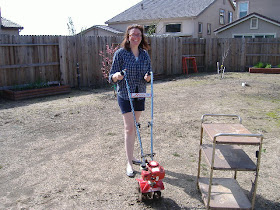Almost
I thought I would get a chance to use three gorgeous days of spring weather to get a head start on preparing the beds that will be a part of the 2009 summer vegetable garden. But, alas, while the sun is up and shining, the winds are also howling through the backyard. This is no time to start tilling up the soil in the raised beds -- as all of that good stuff will just blow into the neighbor's backyard.
So, I find myself inside, praying that the fruit trees don't blow down in this late March blast of wind.
In the meantime, however, the seeds that my dear, wonderful wife planted last February have been popping to the surface. Venus actually planted this bed full of potatoes about two or three weekends ago. This is after I took the Mantis Rototiller to the bed in question, mixing in three or four bags of steer manure compost and two or three cups of pelleted fertilizers designed to supply phosphorus and potash (I figure the steer manure will provide all the nitrogen needed).
And -- as the pictures will show -- so far so good. The bed is really rocking. All of the seed potatoes that Venus planted are now popping to the surface. These aren't your "normal" potatoes. Nope -- what you see here my friends are the varieties of "All Blue" and "Cranberry Red." What's so special about these? Supposedly, these "colored" potatoes retain their color after cooking. And it's just what the wife will need to prepare her "Red, White and Blue" Potato Salad for this year's 4th of July Block Party in North Natomas.
If everything goes according to plan (and when does anything go "according to plan?") -- Venus and I should be harvesting buckets of "All Blue" and "Cranberry Red" potatoes by the end of June. There are others she still hopes to plant in another bed, but alas, Mother Nature is not cooperating with these fierce northern winds.

Other spring crops are
also doing just dandy. This bed, which contains peas in the foreground and a variety of lettuce in the background, was planted in early February. We're already starting to harvest radishes and green onions, and the wife made sure to plant another row of radishes not all that long ago. You can stretch a radish harvest into four or five months during the spring, provided the weather cooperates. However, it just gets a tad too hot for radish plantings in late June and July, so you enjoy them while you can.
There's nothing quite like the bite of a home-grown radish.
Most of the salads prepared for dinner in the past two to three months have been coming via our backyard beds. Venus planted a variety of lettuce and spinach seeds among rows of garlic and onions last fall, which proved to be an extraordinary move. That one 6X2 bed -- against a back fence -- has been throwing out enough lettuce and spinach for full-sized salads nearly every day of the week. And the onions and garlic planted amidst the lettuce and spinach rows? They're growing fatter by the minute. They should be ready for harvest later this summer.
The best, of course, is yet to come. Tomato season is just around the corner.

































